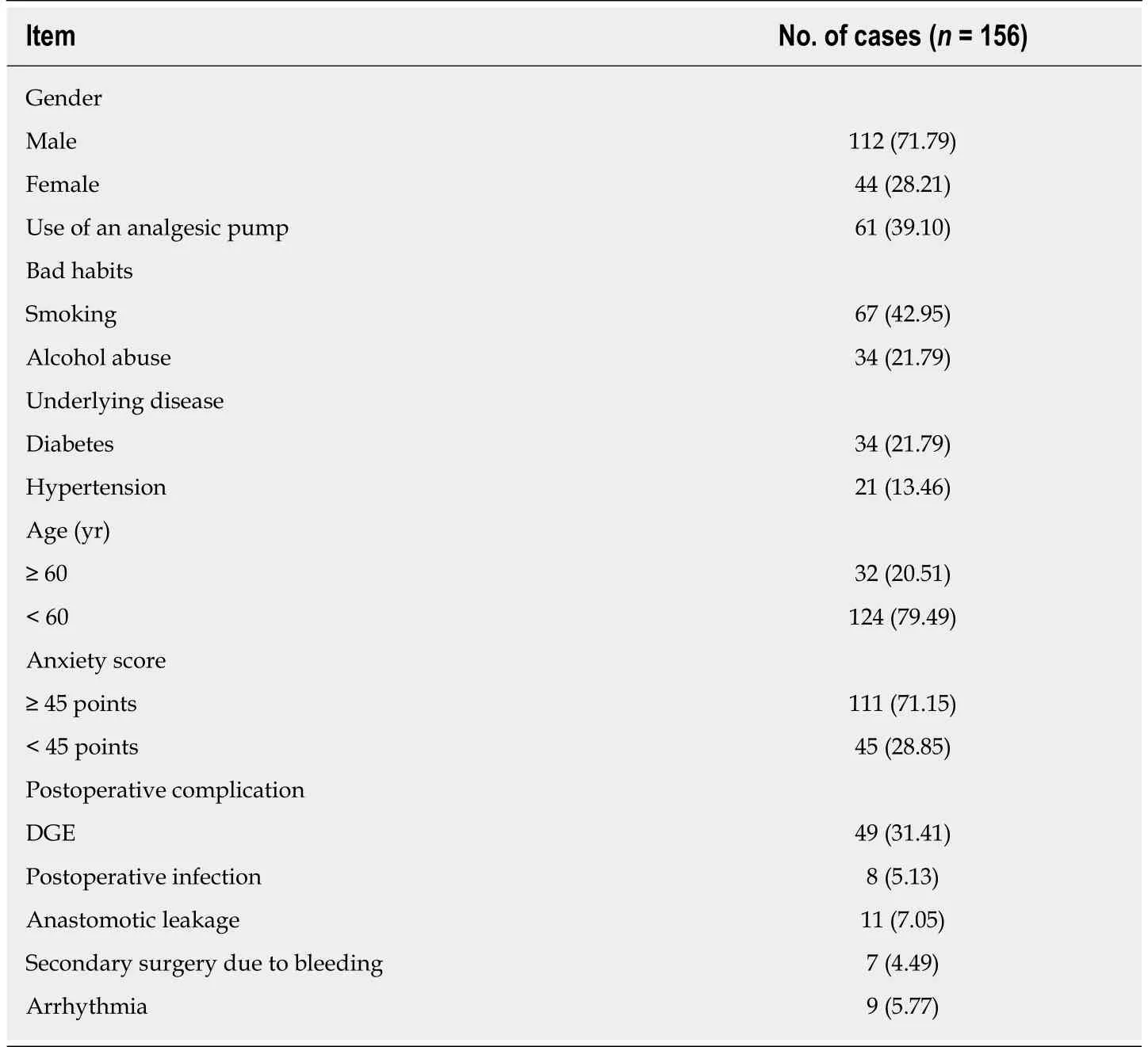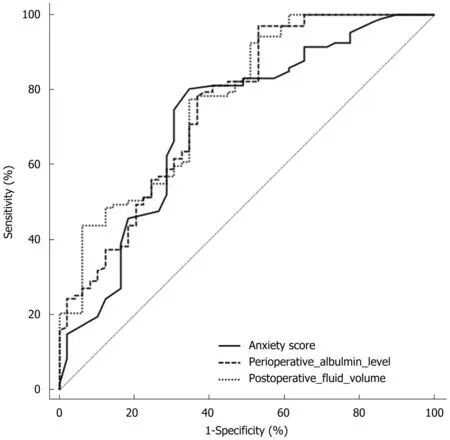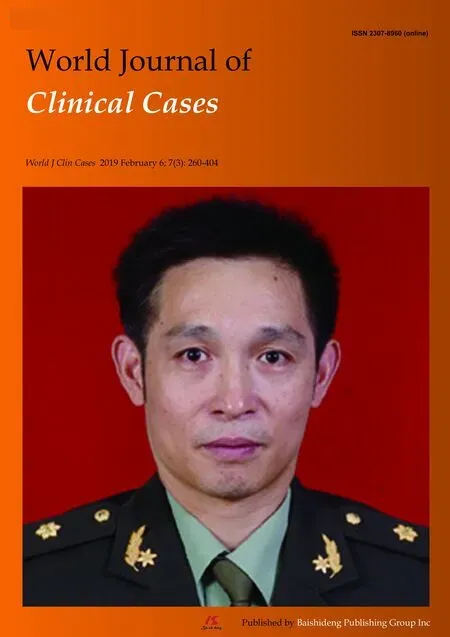Influencing factors of postoperative early delayed gastric emptying after minimally invasive Ivor-Lewis esophagectomy
Lei Huang, Jian-Qiang Wu, Bing Han, Zhi Wen, Pei-Rui Chen, Xiao-Kang Sun, Xiang-Dong Guo,Chang-Ming Zhao
Abstract BACKGROUND The main clinical treatment for esophageal cancer is surgery. Since traditional open esophageal cancer resection has the disadvantages of large trauma, long recovery period, and high postoperative complication rate, its clinical application is gradually reduced. The current report of minimally invasive Ivor-Lewis esophagectomy (MIILE) is increasing. However, researchers found that patients with MIILE had a higher incidence of early delayed gastric emptying (DGE).AIM To investigate the influencing factors of postoperative early DGE after MIILE.METHODS A total of 156 patients diagnosed with esophageal cancer at Deyang People's Hospital were enrolled. According to the criteria of DGE, patients were assigned to a DGE group (n = 49) and a control group (n = 107). The differences between the DGE group and the control group were compared. Multivariate logistic regression analysis was used to further determine the influencing factors of postoperative early DGE. The receiver operating characteristic (ROC) curve was used to assess potential factors in predicting postoperative early DGE.RESULTS Age, intraoperative blood loss, chest drainage time, portion of anxiety score ≥ 45 points, analgesia pump use, postoperative to enteral nutrition interval, and postoperative fluid volume in the DGE group were higher than those in the control group. Perioperative albumin level in the DGE group was lower than that in the control group (P < 0.05). Age, anxiety score, perioperative albumin level,and postoperative fluid volume were independent factors influencing postoperative early DGE, and the differences were statistically significant (P <0.05). The ROC curve analysis revealed that the area under the curve (AUC) for anxiety score was 0.720. The optimum cut-off value was 39, and the sensitivity and specificity were 80.37% and 65.31%, respectively. The AUC for postoperative fluid volume were 0.774. The optimal cut-off value was 1191.86 mL, and the sensitivity and specificity were 65.3% and 77.6%, respectively. The AUC for perioperative albumin level was 0.758. The optimum cut-off value was 26.75 g/L,and the sensitivity and specificity were 97.2% and 46.9%, respectively.CONCLUSION Advanced age, postoperative anxiety, perioperative albumin level, and postoperative fluid volume can increase the incidence of postoperative early DGE.
Key words: Esophageal cancer; Delayed gastric emptying; Minimally invasive Ivor-Lewis esophagectomy; Influencing factors
INTRODUCTION
Esophageal cancer is very common and its incidence is very high in China[1,2]. Surgery is the main approach to treat esophageal cancer[3]. Traditional open esophageal cancer resection is gradually reduced due to its large trauma, long recovery period, and high postoperative complication rate. After nearly 20 years of development, minimally invasive esophageal cancer resection has achieved good results in early and advanced stage esophageal cancer[4,5]. It has the advantages of small wounds, low postoperative infection rate, and short hospital stay[6,7]. In recent years, minimally invasive Ivor-Lewis esophagectomy (MIILE) has been increasingly reported. MIILE reduces the cardiopulmonary stimulation, intraoperative blood loss, and postoperative extrathoracic catheter indwelling time because it avoids intraoperative thoracotomy[8,9]. Meanwhile, due to the use of thoracic laparoscopy in the process of lymph node dissection, the exposure of related nerves is reduced, and the postoperative complications are reduced[10,11]. However, patients treated by MIILE have a high incidence of early delayed gastric emptying (DGE)[12]. Postoperative DGE not only prolongs hospital stay and recovery time, but also increases the incidence of aspiration pneumonia[13,14]. The present study investigated the influencing factors of postoperative early DGE after MIILE in order to take targeted measures to avoid postoperative DGE.
MATERIAL AND METHODS
Participants
A total of 156 patients diagnosed with esophageal cancer by fiberoptic endoscopy at our hospital from January 2015 to October 2017 were enrolled. Among them, 112 patients were male and 44 were female. The average age was 56.64 ± 9.96 years old.The inclusion criteria were as follows: (1) esophageal cancer located in the middle or inferior esophagus; (2) preoperative clinical stage T:1-3, N:0-1, M:0; and (3) patients received MIILE. The exclusion criteria were as follows: (1) patients underwent neoadjuvant therapy or palliative surgery; (2) patients suffering from serious infectious diseases such as tuberculosis and/or cardiopulmonary infarction and other serious organic diseases; (3) patients with preoperative chronic gastrointestinal disease; and (4) patients with incomplete medical records. According to the diagnostic criteria for DGE, patients with postoperative early DGE (within one week) were assigned to a DGE group (n = 49), while patients without DGE were assigned to a control group (n = 107). The present study was approved by the Ethics Committee of our hospital, and each patient signed an informed consent form.
Surgical procedure
Laparoscopic surgery: Patients were placed in the supine position, and artificial pneumoperitoneum was established. A total of five ports were utilized. After the ultrasonic scalpel was placed, the omental tissue of the large curved side of the stomach was separated along the lateral side of the vascular arch of the gastric omentum (Figure 1A), and then the small curved omentum of the stomach was separated (Figure 1B). The stomach was separated up to 1-2 cm above the diaphragmatic esophageal hiatus, down to the beginning of the gastric retinal vascular arch. A linear cutting stapler was used to make a partial tubular stomach along the large curvature of the stomach. Subsequently, the stomach was put into the abdominal cavity in the original position.
Thoracoscopic surgery: Patients was placed in the left lateral position. A total of three ports were utilized. The lymph nodes near the right recurrent laryngeal nerve were cleared (Figure 1C). The odd vein bow was clipped with four HOME locks and the odd vein bow was severed (Figure 1D). The esophagus was separated and the surrounding lymph nodes were cleared. Finally, the esophageal tumor was removed and the intrathoracic lymph nodes were cleared.
Data collection
Baseline data such as age, gender, bad habits (smoking and alcohol abuse), and underlying diseases (diabetes and hypertension) were collected. The perioperative albumin level was measured using an automatic biochemical analyzer. The operative time, intraoperative blood loss, chest drainage time, postoperative fluid volume,interval between surgery and enteral nutrition, use of analgesia pump, and postoperative complications (DGE, postoperative infection, anastomotic leakage,secondary surgery due to bleeding, and arrhythmia) were recorded. A self-evaluation scale was used to evaluate the anxiety of patients after MIILE.
Statistical analysis
Statistical analyses were performed using SPSS20.0. Measurement data are expressed as the mean ± SD. Data between the DGE group and control group were compared by the t-test and chi-square test. Multivariate logistic regression analysis was performed to further determine the influencing factors of early DGE. Receiver operating characteristic (ROC) curve analysis was performed to evaluate the value of potential factors predicting early DGE after MIILE. P < 0.05 was considered statistically significant.
RESULTS
General information of patients with esophageal cancer after MIILE
The general information of patients with esophageal cancer after MIILE revealed that the proportion of males was greater than females, and the majority of patients were under 60 years old. Most patients were in an anxiety state after MIILE. The incidence of DGE was higher compared to that of other postoperative complications (Table 1).
Univariate analysis of influential factors of early postoperative DGE
Comparison between DGE group and the control group showed that the differences of age, intraoperative blood loss, chest drainage time, anxiety score, analgesia pump use, perioperative albumin level, postoperative to enteral nutrition interval and postoperative fluid volume were statistically significant (P < 0.05). Among them, age,the intraoperative blood loss, chest drainage time, portion of anxiety score ≥ 45 points,portion of analgesia pump use, postoperative to enteral nutrition interval, and postoperative fluid volume in the DGE group were higher than those in the control group. The perioperative albumin level in the DGE group was lower than that in the control group. The differences of gender, surgery time, and diabetes were not statistically significant (P > 0.05, Table 2).

Figure 1 Surgical procedure of minimally invasive Ivor-Lewis esophagectomy. A: The large curved side of the stomach was separated; B: The small curved omentum of the stomach was separated; C: The lymph nodes near the right recurrent laryngeal nerve were cleared; D: The odd vein bow was clipped and severed.
Multivariate analysis for the occurrence of postoperative early DGE
The multivariate logistic regression analysis revealed that chest drainage time,intraoperative blood loss, analgesia pump use, and interval between surgery and enteral nutrition were not independent factors influencing early postoperative DGE (P> 0.05). Age, anxiety score, perioperative albumin level, and postoperative fluid volume were independent factors influencing early postoperative DGE, and the differences were statistically significant (P < 0.05). Furthermore, according to the odds ratio value, the order of the indicators affecting the degree of early postoperative DEG was: anxiety score, postoperative fluid volume, age, and perioperative albumin level(Table 3).
ROC curve analysis
The ROC curve analysis revealed that the areas under the curves (AUCs) for anxiety score, postoperative fluid volume, and perioperative albumin level were 0.720, 0.774 and 0.758, respectively. The optimal cut-off value of anxiety score was 39, and the sensitivity and specificity were 80.37% and 65.31%, respectively. For postoperative fluid volume, the optimal cut-off value was 1191.86 mL, and the sensitivity and specificity were 65.3% and 77.6%, respectively. For perioperative albumin level, the optimum cut-off value was 26.75 g/L, and the sensitivity and specificity were 97.2%and 46.9%, respectively (Figure 2).
DISCUSSION
Esophageal cancer has a high incidence in China and is the second largest malignant tumor of the digestive tract after gastric cancer[15-18]. Currently, the surgical procedures for esophageal cancer are constantly improving and innovating[19-22]. MIILE has gradually become the main surgical procedure for advanced esophageal cancer in clinical treatment. However, in addition to the difficulty of surgery operation, MIILE also has a high incidence of postoperative early DGE. Postoperative early DGE is mainly a functional emptying disorder, which not only affects the enthusiasm of postoperative rehabilitation, but also increases the risk of other complications such as anastomotic leakage. Hence, it is important to identify the reason of postoperativeearly DGE and assess early intervention.

Table 1 General information of patients with esophageal cancer after minimally invasive Ivor-Lewis esophagectomy n (%)
The pathogenesis of DGE remains unclear. Studies have found that preoperative and postoperative mental stress, and changes in hormones induced by trauma and surgical stress are the main mechanisms that lead to postoperative DGE[23-26]. In the present study, the postoperative mental state of the patients was analyzed by anxiety score. The anxiety score of the DGE group was significantly higher than that of the control group. Furthermore, the logistic regression analysis revealed that anxiety score was one of the independent factors influencing postoperative early DEG,suggesting that postoperative anxiety is likely to be the reason of DGE. The ROC curve analysis revealed that the AUC of anxiety score was 0.72. It indicated that the anxiety score could predict the occurrence of postoperative early DGE to some extent.Therefore, effective postoperative psychological counseling is helpful to prevent the occurrence of DGE. Epidemiological surveys show that esophageal cancer is common in middle-aged and elderly people, while elderly patients themselves are suffering from gastrointestinal dysfunction accompanied by aging, and have reduced tolerance and resilience to surgery. Therefore, postoperative observation of elderly patients should be more detailed.
A study conducted by Cheong et al[27]revealed that postoperative hypoalbuminemia can easily lead to anastomotic edema, cause local motor dysfunction, and thereby affect gastrointestinal function recovery. By comparing perioperative albumin levels between the DGE group and control group, it was found that albumin level was significantly lower in the DGE group. Furthermore, logistic regression analysis revealed that high perioperative albumin level was a protective factor for postoperative DGE. Therefore, timely enteral nutrition to improve albumin level is important for preventing DGE. Furthermore, the present study found that postoperative fluid volume also affected the occurrence of DGE, and postoperative rehydration was a risk factor for this complication. The ROC curve analysis revealed that the AUC of postoperative fluid volume was higher than that of perioperative albumin level. It indicates that the prediction ability of postoperative fluid volume is stronger. Moreover, the multivariate analysis revealed that the effect of postoperative fluid volume was higher. These imply that excessive fluid rehydration during enteral nutrition may promote the occurrence of DGE. Therefore, caution should be given forrehydration after surgery, and this should be based on the diagnosis of patient's vital signs.

Table 2 Univariate analysis of influential factors for early postoperative delayed gastric emptying in patients with esophageal cancer
Studies also revealed that the interval between surgery and enteral nutrition promotes DGE[28-30]. However, in the present study, the multivariate analysis result revealed that the interval between surgery and enteral nutrition had no significant effect on the occurrence of DGE. It implies that further exploration such as expanding the sample size may be needed.
In summary, the present study found that advanced age, postoperative anxiety,perioperative albumin level, and postoperative fluid volume can increase the incidence of postoperative early DGE. Evaluating the anxiety score, perioperative albumin level, and postoperative fluid volume can predict the occurrence of postoperative DGE. These findings help improve postoperative care to prevent postoperative complications.

Table 3 Logistic regression analysis of influencing factors for early postoperative delayed gastric emptying in esophageal cancer patients

Figure 2 Receiver operating characteristic curve analysis for predicting postoperative early delayed gastric emptying in esophageal cancer patients.
ARTICLE HIGHLIGHTS
Research background
Esophageal cancer is the second largest digestive tract malignancy after gastric cancer. The surgical procedures for esophageal cancer are constantly improving and innovating. Due to its minimally invasive and precise features, minimally invasive Ivor-Lewis esophagectomy (MIILE)significantly reduces the incidence of complications in patients undergoing surgery. It is superior to traditional open surgery and has gradually become the main surgical procedure for advanced esophageal cancer in clinical treatment.
Research motivation
MIILE also has the disadvantages that needto be overcome. In addition to the disadvantages of high surgical difficulty, MIILE has a relatively high incidence of complications such as postoperative early delayed gastric emptying (DGE). Postoperative DGE is a functional emptying disorder. It will not only affect the enthusiasm of postoperative rehabilitation, but also increase the risk of other complications such as anastomotic leakage. It may lead to patients undergoing secondary surgery. Therefore, it is the current top priority to find out the precise cause of early DGE and provide early intervention.
Research objectives
The present study aimed to compare the differences between patients with postoperative early DGE and those without, in order to explore the influencing factors of postoperative early DGE after MIILE.
Research methods
A total of 156 patients with esophageal cancer diagnosed at our hospital were recruited. All patients were treated by MIILE. According to the DGE diagnostic criteria, patients were divided into a DGE group if DGE was found in the early postoperative period (within one week). While patients were divided into a control group if DGE was not found in the early postoperative period. Various data of the DGE group and the control group were recorded and compared, and single factor analysis was performed. Multivariate logistic regression analysis was performed to further determine the extent of these factors’ effect on early postoperative DGE. The ROC curve was used to analyze the accuracy of these factors in predicting the early postoperative DGE.
Research results
Multivariate logistic regression analysis showed that age, anxiety score, perioperative albumin level, and postoperative fluid volume were the independent factors influencing postoperative early DGE. The receiver operating characteristic curve analysis revealed that the area under the curve (AUC) for anxiety score was 0.720, and the sensitivity and specificity were 80.37% and 65.31%, respectively. The AUC, sensitivity, and specificity for postoperative fluid volume were 0.774, 65.3%, and 77.6%, respectively. Regarding perioperative albumin level, they were 0.758,97.2%, and 46.9%, respectively. However, studies have shown that the time interval from surgery to enteral nutrition also contributes to the early postoperative DGE, but this study found that the time interval from surgery to enteral nutrition had no significant effect on postoperative early DGE. It implied that our research may have a limited sample size and further research is necessary.
Research conclusions
The present study found that advanced age, postoperative anxiety, perioperative albumin level,and postoperative fluid volume were the independent factors influencing postoperative early DGE. These indicators are expected to be used to predict the occurrence of postoperative early DGE.
Research perspectives
The findings of this study will help to further guide the care and treatment of postoperative patients, thereby preventing the occurrence of early postoperative DGE, and improving the quality of postoperative life of patients with esophageal cancer.
 World Journal of Clinical Cases2019年3期
World Journal of Clinical Cases2019年3期
- World Journal of Clinical Cases的其它文章
- Overexpression of HSP27 and HSP70 is associated with decreased survival among patients with esophageal adenocarcinoma
- Incidence, risk factors, and outcome of BK polyomavirus infection after kidney transplantation
- Split-dose or hybrid nonsteroidal anti-inflammatory drugs and Nacetylcysteine therapy for prevention of post-retrograde cholangiopancreatography pancreatitis Laura Pavel, Gheorghe Gh B?lan, Alexandra Nicorescu, Georgiana Emmanuela
- Celiac crisis, a rare occurrence in adult celiac disease: A systematic review
- Hand-assisted laparoscopic splenectomy is a useful surgical treatment method for patients with excessive splenomegaly: A metaanalysis
- Successful treatment of obstructing colonic cancer by combining self-expandable stent and neoadjuvant chemotherapy: A case report
